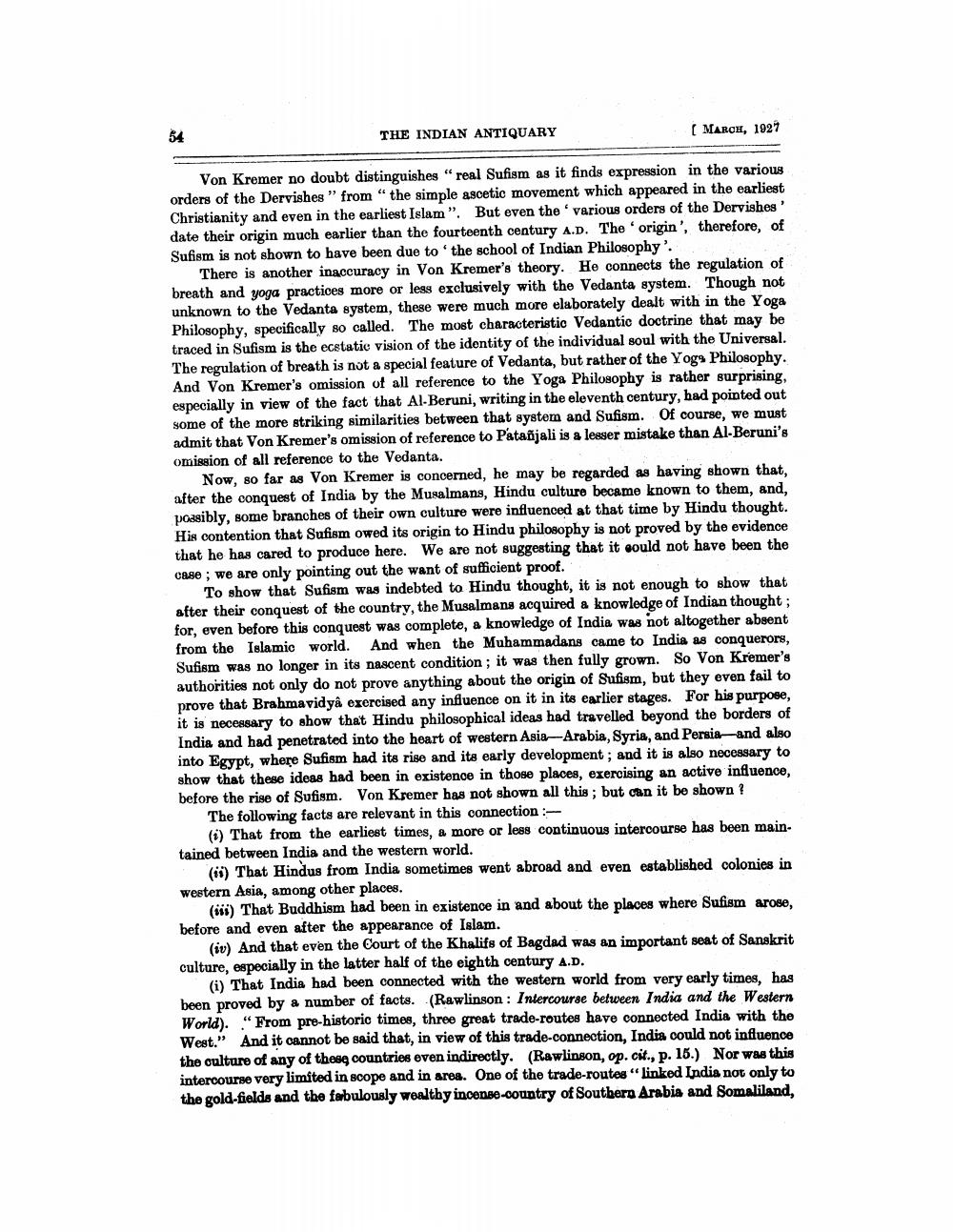________________
THE INDIAN ANTIQUARY
(MARCH, 1927
Von Kremer no doubt distinguishes "real Sufism as it finds expression in the various orders of the Dervishes" from " the simple ascetic movement which appeared in the earliest Christianity and even in the earliest Islam". But even the various orders of the Dervishes date their origin much earlier than the fourteenth century A.D. The origin', therefore, of Sufism is not shown to have been due to the school of Indian Philosophy'.
There is another inaccuracy in Von Kremer's theory. He connects the regulation of breath and yoga practices more or less exclusively with the Vedanta system. Though not unknown to the Vedanta system, these were much more elaborately dealt with in the Yoga Philosophy, specifically so called. The most characteristic Vedantic doctrine that may be traced in Sufism is the ecstatic vision of the identity of the individual soul with the Universal. The regulation of breath is not a special feature of Vedanta, but rather of the Yogs Philosophy. And Von Kremer's omission of all reference to the Yoga Philosophy is rather surprising, especially in view of the fact that Al-Beruni, writing in the eleventh century, had pointed out some of the more striking similarities between that system and Sufism. Of course, we must admit that Von Kremer's omission of reference to Patañjali is a lesser mistake than Al-Beruni's omission of all reference to the Vedanta.
Now, so far as Von Kremer is concerned, he may be regarded as having shown that, after the conquest of India by the Musalmans, Hindu culture became known to them, and, poasibly, some branches of their own culture were influenced at that time by Hindu thought. His contention that Sufism owed its origin to Hindu philosophy is not proved by the evidence that he has cared to produce here. We are not suggesting that it would not have been the case; we are only pointing out the want of sufficient proof.
To show that Sufism was indebted to Hindu thought, it is not enough to show that after their conquest of the country, the Musalmans acquired a knowledge of Indian thought ; for, even before this conquest was complete, a knowledge of India was not altogether absent from the Islamic world. And when the Muhammadans came to India as conquerors, Sufism was no longer in its nascent condition; it was then fully grown. So Von Kremer's authorities not only do not prove anything about the origin of Sufism, but they even fail to prove that Brahmavidyâ exercised any influence on it in its earlier stages. For his purpose, it is necessary to show that Hindu philosophical ideas had travelled beyond the borders of India and had penetrated into the heart of western Asia-Arabia, Syria, and Persia and also into Egypt, where Sufism had its rise and its early development, and it is also necessary to show that these ideas had been in existence in those places, exercising an active influence, before the rise of Sufism. Von Kremer has not shown all this; but can it be shown?
The following facts are relevant in this connection:
(i) That from the earliest times, & more or less continuous intercourse has been maintained between India and the western world.
(10) That Hindus from India sometimes went abroad and even established colonies in western Asia, among other places.
() That Buddhism had been in existence in and about the places where Sufism arose, before and even after the appearance of Islam.
(iv) And that even the Court of the Khalifs of Bagdad was an important seat of Sanskrit culture, especially in the latter half of the eighth century A.D.
(i) That India had been connected with the western world from very early times, has been proved by a number of facts. (Rawlinson: Intercourse between India and the Western World). "From pre-historic times, three great trade-routes have connected India with the West." And it cannot be said that, in view of this trade-connection, India could not influence the culture of any of these countries even indirectly. (Rawlinson, op. cit., p. 15.) Nor was this intercourse very limited in scope and in area. One of the trade-routes" linked India not only to the gold-fields and the fabulously wealthy incense-country of Southern Arabia and Somaliland,




